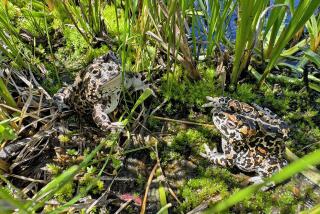Bufo : Scientists Adore Traveling Toad, Warts and All
- Share via
Call him Bufo if you like. That squishy creature crawling by the thousands these days from the river banks of Sepulveda Basin is Bufo boreas , to be scientifically correct.
As the name seems to hint, he is a bit of a buffoon among amphibians.
His close relative, the frog, has long, powerful legs, a narrow waist and a manly call.
Bufo is a toad. His legs are short, his waist is dumpy and his voice is just a squeak. To defend himself, he secretes a noxious, milky substance over his bumpy skin.
If the description doesn’t sound too flattering, Bufo still manages to endear himself to biologists like Jim W. Dole of California State University, Northridge.
Dole, who has studied the toad in its San Fernando Valley habitat, said he thinks of it more as a clown.
He also admires its ability to survive conditions imposed by man.
The Western toad, as B. boreas is commonly called, is native to the ponds along the Los Angeles River and its tributaries. Today it faces no particular threat, even though its natural habitat has largely been covered with concrete.
“They’re doing quite well,” Dole said. “They seem to adapt to the human habitat pretty nicely as long as there is moisture.”
Having just metamorphosed from tadpoles, they are emerging from ponds along the river bottom in such numbers, Dole said, that, if you go for a look, “you can’t help stepping on them.”
Because of the milky secretion, the toad has few natural enemies besides man.
Occasionally, a dog will try to eat one, and regret it.
“If he’s a smart dog, he’ll do it only once,” Dole said. “The biggest problem with toads is we tend to run over them.”
That’s because the life cycle of the toad requires it to venture from the breeding pond into the unknown.
“After a period of months, they will disperse or die,” Dole said.
Some die anyway, victims of the heat and dryness of the concrete bank.
The fittest--or most fortunate--get over the top and then go looking for a backyard or a golf course to live in. That means crossing busy roads.
The saga of a toad’s search for a home draws almost poetic admiration from a curator of the Los Angeles County Museum of Natural History.
“They just start hopping until they find a place where they can eke out a living,” Robert L. Bezy, assistant curator of herpetology at the museum, said. “If they make their way through all the accidents that befall them leaving on their great trek to go out and make a home, if they survive for a year or two, they have to go on that same trek again. They have to cross over the same roads and make it back to breed.”
Scientists don’t know exactly how nature leads the toad, like a salmon, back to the pond where it was born.
Dole and an associate have written a scientific paper on the homing ability of Bufo boreas . They based it on experiments they conducted at Seminole Lake in the Santa Monica Mountains.
The two biologists caught the toads in their breeding grounds and turned them loose at night a hundred meters or so away.
To track their specimens in the dark, they harnessed each one to a device containing 70 meters of thread.
By daylight, they followed each thread to the toad at its end.
This is what they found:
On a clear night, almost all the toads struck out in the direction of their breeding ponds. When it was overcast, some strayed to the right or left. Toads that had their eyes cut out could do just as well as healthy ones under cloudy skies, but those whose olfactory nerve was severed tended to wander around in the night in all directions.
They concluded that a toad smells its way home but can set a truer course if it has starlight to guide it.
And, undoubtedly, they’re probably safer on the roads by starlight.
More to Read
Sign up for Essential California
The most important California stories and recommendations in your inbox every morning.
You may occasionally receive promotional content from the Los Angeles Times.














